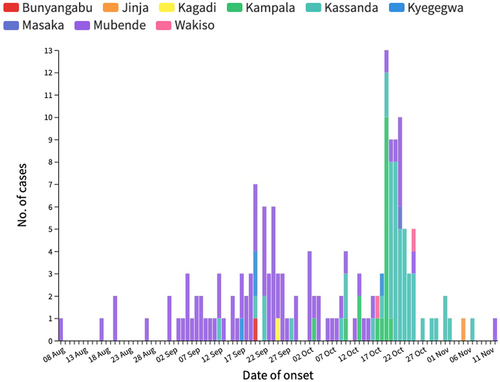2022 Uganda Ebola outbreak: Early descriptions and open data
During the early stages of epidemics, obtaining reliable, ready-to-use, and well-defined epidemiological data is challenging. Traditional surveillance approaches, such as monitoring the number of cases and deaths, are not enough to manage such a complex public health threat. The COVID-19 pandemic demonstrated how important open data are for supporting public health policy decisions and improving clinical trials. Recent approaches to surveillance include “crowdsourcing open-source case-based data.”1 Such data enable governments to provide effective, timely, and inclusive responses to manage an outbreak, and research community to understand the origins and transmission dynamics of an outbreak2; estimate basic properties of the disease such as the incubation period and reproduction number3; build predictive models for tracking virus spread in real time.4
A new outbreak of Ebola virus disease (EVD) due to Sudan ebolavirus is spreading rapidly in Uganda (Figure 1) and as of October 12, 2022, has been reported in nine districts. Real-time data collection is necessary to (i) facilitate coordination and collaboration between national and local authorities; (ii) ensure public trust in government through increased transparency and better communication; (iii) counteract misinformation; (iv) identify and address vulnerabilities and specific needs of vulnerable groups by collecting disaggregated data; and (v) support effective management of medical supplies and demands.

For this reason, we routinely collect information on the number of EVD cases in an open and machine-readable repository from verified sources, including reports from the Uganda Ministry of Health5 and public health organizations such as the European Centre for Disease Prevention and Control (ECDC). In addition, as long it becomes available from any of the monitored sources, information on gender, dates of symptom onset, locations (aggregated to the district level), and the status of hospitals will be included, also reporting bed capacity and isolation unit occupancy rate according to the severity status of the patient.
Data are freely available in an open, machine-readable repository at: https://github.com/fbranda/ebola. The repository allows for real-time monitoring during the current Ebola outbreak, as it provides timely, complete, and easy-accessible data collected from multiple sources. This favors a rapid global response to Ebola, enabling governments to prioritize and adjust their decisions quickly and effectively in response to the rapidly evolving emergency, with a solid data basis.
CONFLICT OF INTEREST
The authors declare no conflict of interest.




